5 Signs to Scale Your Influencer Marketing (and How to Do It)
Trying to figure out how to scale your influencer program? This post breaks down tell-tale signs you should scale your influencer marketing and ways...
What should you do if your boss doesn’t understand influencer marketing? Below we share talking points and how to handle common concerns from higher-ups.


If you’re struggling to explain the value of influencer marketing to your boss, you’re not alone.
That’s because many critics still don’t quite understand the concept. Marketers, too.
Food for thought: 89% of brands will maintain or boost their spending on influencers this year.
Translation? Influencer marketing is not a shiny new toy anymore. It’s a proven tactic.
Still, you can’t run a campaign until you get buy-in from your boss. That’s why we wrote this post breaking down influencer marketing so you can break it down for others. Below you’ll learn:
We’ll bite: defining influencer marketing can be tricky.
There are a lot of moving pieces involved. Campaigns aren’t one-size-fits-all, either.
From gifting to ambassador programs, boiling everything into a single definition is tough.
That’s why we recommend focusing on the big-picture before getting into specifics. Let’s define influencer marketing in basic, kitchen-table terms:
The explanation above covers the basics of influencer marketing and its benefits. Need to simplify the concept even more for a non-marketer? To “do” influencer marketing means to…
Partner with social media creators to promote products to our target audience. We share our products with them and they share those products with their followers.
It’s not 2013 anymore — that’s a good thing for brands working with influencers!
While influencer marketing used to be like the wild west, times have changed. Long gone are the days of low-effort promo posts (like Scott Disick’s infamous Instagram fail).
Influencer marketing has matured into an established channel with a massive audience. Enough time has passed that brands understand what works and what doesn’t.
The fact that the global influencer market is worth over $16 billion dollars says it all.
That said, maybe your boss doesn’t understand the shift in the influencer space.
Fair enough! There are still a lot of misconceptions about influencer marketing. Ready to debunk them? Below we explain the state of influencers and how they’ve changed.
For years, the term “influencer” was associated with social media “power users.”
You know, folks with millions of followers. The Kardashians and stereotypical celebrities.
Fast-forward to the present. Influencers come in all shapes and sizes. Specifically, the definition of “influencer” now includes everyday social creators. Not to mention friends, family and people that aren’t actively promoting themselves.
Here’s a quick snapshot of the types of influencers that brands partner with:
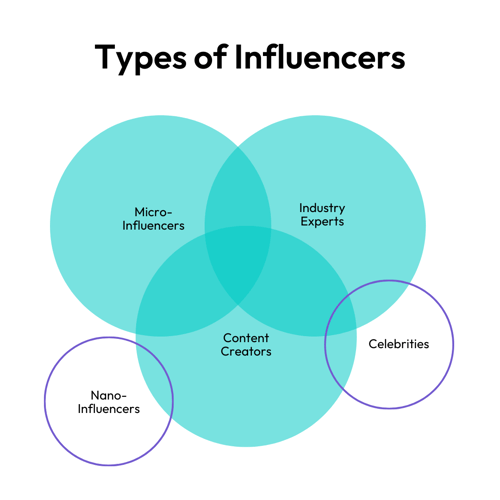
Notice how celebrities aren’t the focal point? That’s because modern consumers consciously gravitate to smaller creators for product recommendations. Brands are hiring more smaller creators as a result.
We’ve found that creators with anywhere from ~2,000 to ~25,000 followers seem to be the best fit for brands engagement-wise. Fact: micro-influencers with less than 5,000 followers earn the highest engagement rates on their content.
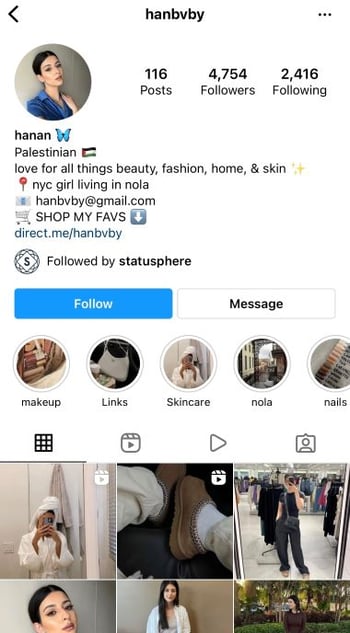
Source: @hanbvby
The takeaway? Follower count doesn't define an influencer’s value to brands. Not by a long shot.
Instead, brands should focus on whether the creators they partner with have an audience that resembles their own. The right creators provide a direct line to highly specific (and engaged!) potential customers.
Sure, beauty brands and fashion products dominate the influencer space.
But there’s plenty of room for brands to shine even if you're in a less “glamorous” industry.
If you need evidence, look no further than all the products being promoted on TikTok. No matter what you’re selling, there’s a community of consumers and creators out there for you.
We’ve found that it’s “unconventional” products that often pop off on TikTok.

Source: @fabiola.poled
Where else are videos about products like reusable toilet paper earning thousands of views? There’s a reason why CPG brands are flocking to the platform right now.
Influencers are making short-form videos on TikTok and Instagram to promote brands like never before. Both platforms can benefit brands and where you run campaigns depends on your audience.
On that note, Instagram isn’t the only show in town for brands working with influencers.
We’ve seen firsthand how brands are making the leap to TikTok. According to TikTok themselves, brands that work with creators build greater loyalty. This includes driving greater purchase intent, engagement and brand favorability.
Spoiler alert: consumers at large know what influencer marketing looks like. They understand when people are promoting products on behalf of brands. It’s not a big secret.
That said, influencer recs are still incredibly effective. That’s because consumers want to see products in the hands of real people. This applies to influencers and everyday content creators, too.
This speaks to the value of finding authentic influencers that your customers can relate to. A skilled influencer knows how to show off products in a way that doesn’t feel “salesy” at all.
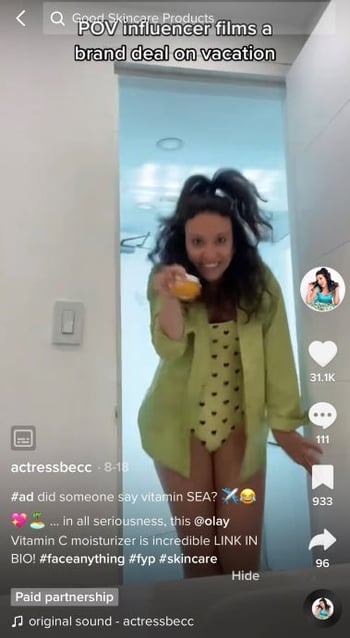

Source: @actressbecc
Peek this comment: “HOW LONG IT TOOK ME TO REALIZE THIS ACTUALLY IS AN AD.”
That’s the power of authentic creator content in action.
Sure, influencer marketing is people-centric.
But results and performance are trackable just like any other marketing channel.
Consider that influencers are very much aware of their own performance metrics. This includes reach, engagement and how many people interact with their content.
Having this knowledge is important for influencers to attract brands. More importantly, a creator’s native metrics highlight whether their audience loves their content.
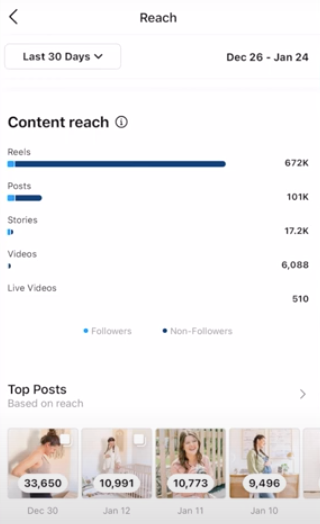
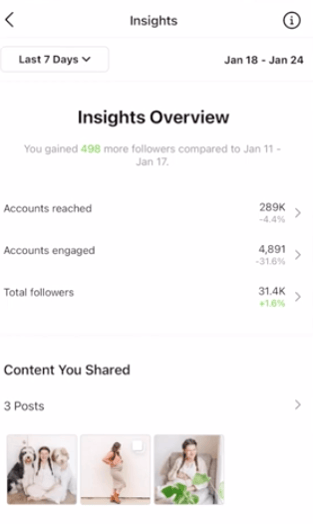
Source: YouTube
Skeptics might assume that creator campaigns leave brands in the dark when it comes to analytics.
The reality, though? Results are totally trackable. This means that influencer marketing can be just as data-driven as your campaigns elsewhere.
For brands focused on awareness, interactions and earning more UGC, all of the above can be measured with ease. In fact, direct sales are the only real gray area of tracking performance.
Here's a look at influencer marketing ROI by the numbers:
Also, it’s notable that influencer marketing campaigns don’t have to be “one and done.” Like marketing channels like SEO or email, many brands approach influencers as a long-term play. We find that always-on campaigns are effective for engagement and ongoing influencer content.
“Okay, I think I get it. But how do you actually ‘do’ influencer marketing?”
Being able to define influencer marketing isn’t the be-all, end-all of explaining it to your boss. You should likewise be able to break down the actual steps involved in running a campaign.
Here’s a quick snapshot of the steps involved in the process. Specifics will vary depending on the type of campaign you’re running but here’s the big picture:
Brands should approach influencer marketing with a sense of confidence.
Likewise, your higher-ups should feel comfortable before signing off on a campaign. Crystal-clear expectations are key to a successful rollout.
Don’t be surprised if you still get pushback even from people that want to get on board. To wrap things up, let’s review common objections to influencer marketing and ways to respond to them.
|
Objection |
Sample Response |
| 1. “We’re already investing in social media, PPC, email and SEO.”
3. “We should be able to tell influencers exactly what to say.”
|
|
Listen: don’t get discouraged if your boss doesn’t understand influencer marketing.
We get it! Again, there are a lot of moving pieces involved. Our advice is to start with the big-picture concept. Then, be prepared to answer questions and respond to objections.
By understanding the points outlined above, you’ll be perfectly equipped to do exactly that.
For newcomers to influencer campaigns, it’s easy to get overwhelmed and second-guess what to do. That’s where Statusphere can help.
Our turnkey influencer marketing platform handles all of the heavy lifting related to your campaigns. This includes matchmaking, fulfillment and tracking content performance.
We remove the guesswork and question marks related to influencer marketing by matching brands with creators who want to promote your products.
Want to learn more about how our platform works? Get in touch with one of our consumer-to-consumer marketing specialists to see how we can get creators posting about your brand ASAP.

Trying to figure out how to scale your influencer program? This post breaks down tell-tale signs you should scale your influencer marketing and ways...
Not sure where you should run your next influencer marketing campaign? Below we explain the benefits of TikTok vs. Instagram to help you choose.
UGC creators are all the rage right now! We explain who these creators are, whether they're right for your brand and the difference between UGC and...
Be the first to know about the latest tools, trends and strategies in influencer marketing for brands.